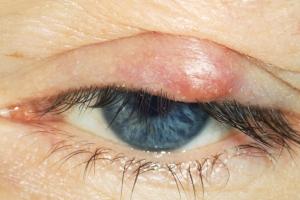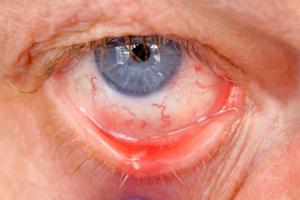Table of Contents
ToggleStye
Stye is defined as a localized infection of the hair follicles or sebaceous glands of the eyelids
OR
Is a staphylococcal abscess that may occur on either the external or internal margin of the eyelid
Cause
- Staphylococcus aureus
Types of stye
There are three general types of stye:
- an external stye – a swelling that develops along the edge of your eyelid – it may turn into a yellow pus-filled spot that’s painful to touch
- an internal stye – a swelling that develops on the inside of your eyelid – it’s usually less painful than an external stye
- a chalazion – a swollen bump on the eyelid. It happens when the eyelid’s oil gland clogs up. It may start as an internal hordeolum (stye)
External styes

A stye on the outside of the eyelid may be caused by an infection of:
- an eyelash follicle – these are small holes in your skin that individual eyelashes grow out of
- the sebaceous gland – this gland is attached to the eyelash follicle and produces an oily substance called sebum, which lubricates the eyelash to prevent it from drying out
- the apocrine (Moll) gland – this sweat gland empties into the eyelash follicle and helps prevent the eye drying from out
Internal styes

Internal styes can occur when the meibomian glands become infected. These glands are found on the eyelids. They produce an oily liquid that makes up part of the tear film that covers your eye.
If the glands become blocked, a cyst can develop, which can become infected.
Chalazion
A chalazion can develop and you might not see any symptoms. When there are symptoms, they can include:
- a bump on the eyelid, sometimes becoming red and swollen. Occasionally it can be tender.
- rarely, an entirely swollen eyelid
- blurry vision, if the chalazion is large enough to press on the eyeball
Clinical Features
- Redness on the affected area
- Pain
- Tenderness
- Itching
- Photophobia
- Pus formation
- Yellowish swelling 3 days b4 opening spontaneously
- May burst spontaneously
- Itching in the early stages
- A lump on the top or bottom eyelid
- Swelling, pain & tenderness
- Pus formation
- Watering of the eye
- Eye is sensitive to light
- Small area of the eyelid is swollen but sometimes the entire eyelid swells up
- Tiny, yellowish spot develops at the center of the swollen area
- Discomfort during blinking
- Sensation of a foreign body in the eye
- Mucous discharge in the eye
- Blurred vision
- Crusting of the eyelid margins
- Burning in the eye
Management of a Stye
- Usually the stye will heal spontaneously
- Avoid rubbing the eye as this might spread the infection
- Apply a warm/ hot compress to the eye for 10 minutes
- Apply tetracycline eye ointment 1% 2-4 times daily until 2 days after symptoms have disappeared
- Remove the eye lash when it’s loose
- When the forms in one of the deeper glands of the eyelid a condition is called internal hordeolum
- The pain and other symptoms are usually more severe.
- Because this type of the stye rarely ruptures by it self, a doctor may have to open it to drain the pus
Note
- Internal stye tend to recur
Surgery
- Incision and drainage is performed if resolution does not begin in the next 48 hours after warm compresses are started
- The procedure consists of making a small incision on the inner or outer surface of the eyelid and the pus is drained out of the gland, and very small sutures are used to close the lesion
Prevention
- Good personal hygiene, Proper hand washing
- Regular washing of the face
- Remove any loose eyelashes
- it is recommended to never share cosmetics or cosmetic eye tools with other people
- It is also recommended to remove makeup every night before going to sleep and discard old or contaminated eye makeup.





Very interestingnly nice,I enjoyed the I fo.
very nice topic
Very nice and precise work
Have learned a lot from the topic